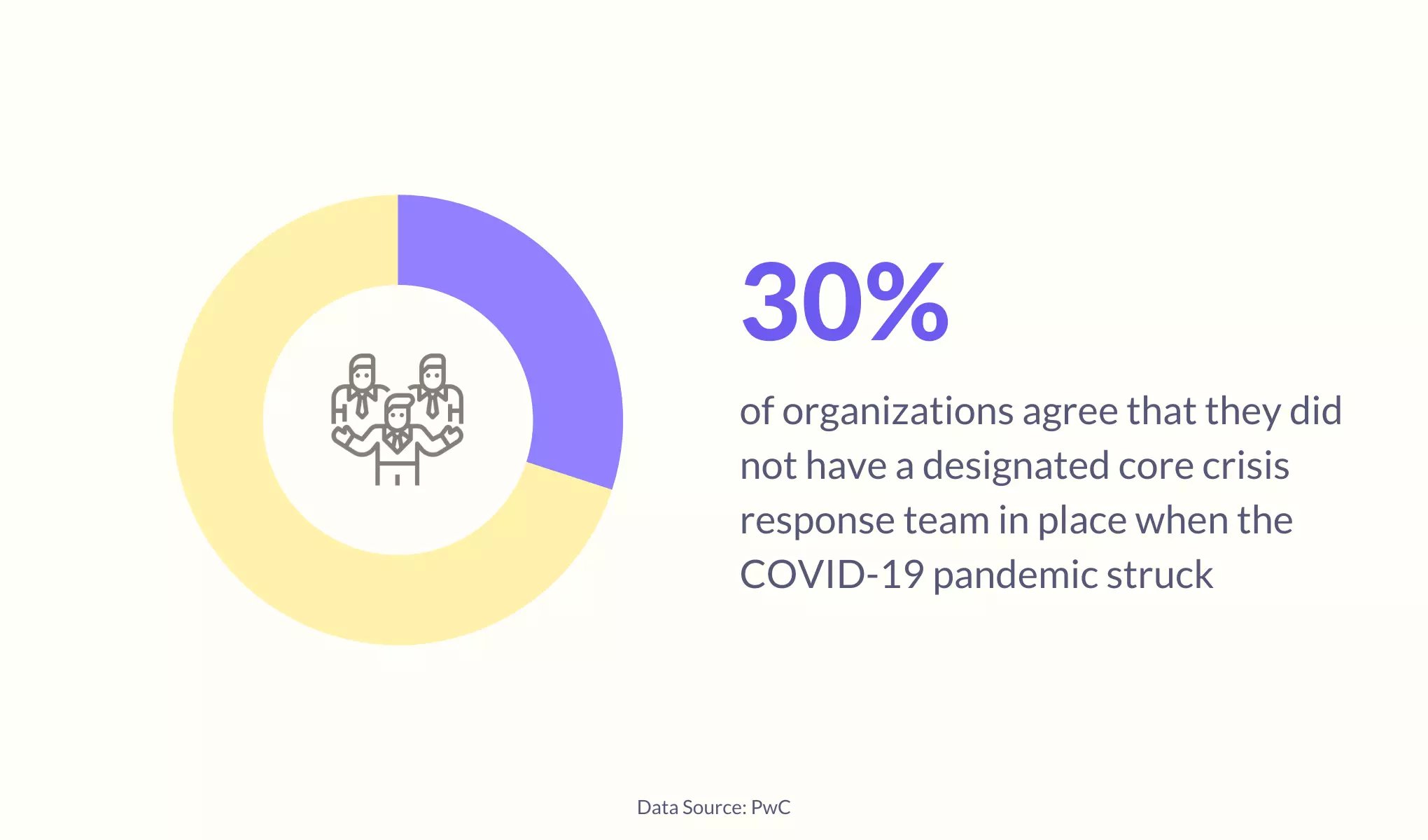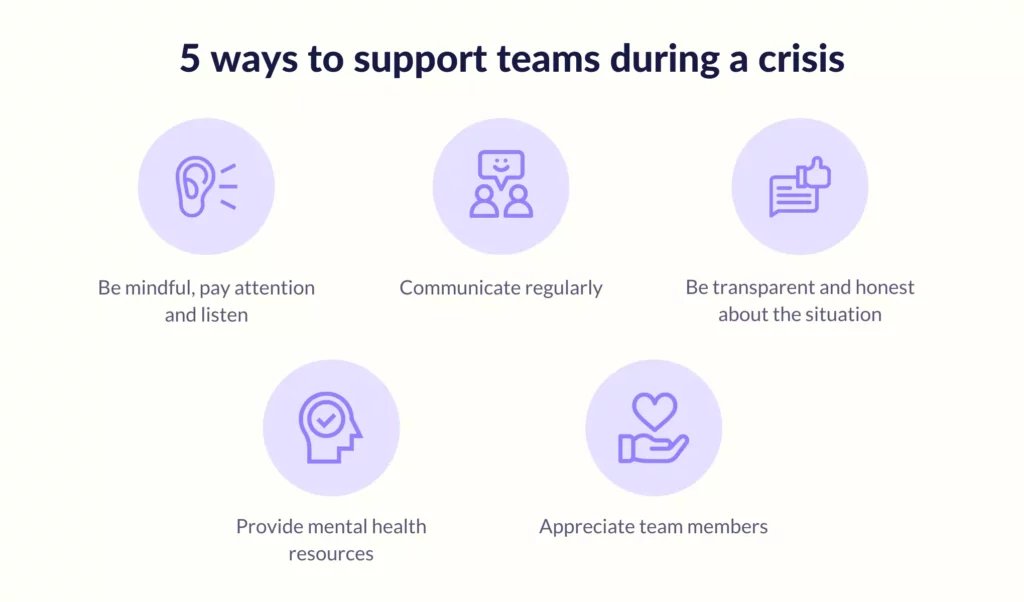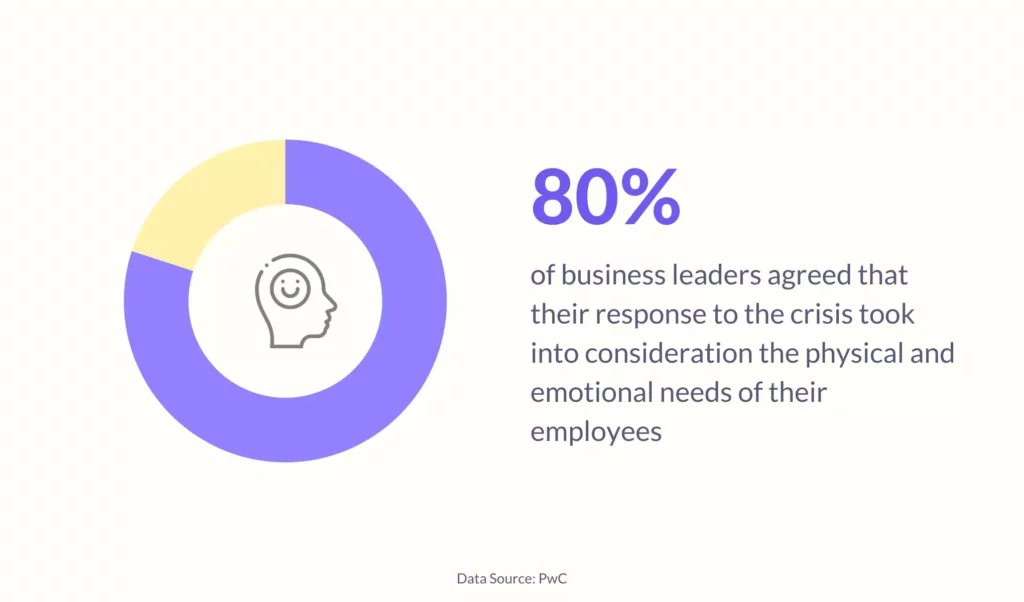A Guide to Crisis Management Planning for Customer Service Leaders

Table of contents
Does your business have a crisis management plan in place for your customer service team to handle an unexpected, unpredictable, or even unthinkable disaster?
While managing through a crisis, your customer service becomes a critical focal point for communication.
That’s because your customers are relying on you, now more than ever. They need information and updates. They may be so stressed, upset, or angry that they want to cancel their orders or receive refunds.
Your support team will experience a higher call volume than normal, while your reps handle inquiries, soothe panic, and reassure callers. They’ll need to show even more empathy than usual without caving to the pressure themselves.
But just because emergencies are unpredictable, it doesn’t mean you need to be blindsided by them. Crisis handling should be done ahead of time so as to mitigate the damage. Your team needn’t have full information about exactly what’s going to happen to create contingency plans — and you shouldn’t wait until you do.
This post will help your customer support team learn how to manage a crisis and provide customers uninterrupted support during a crisis.
Table of Contents
- What constitutes a crisis in business?
- What is crisis management?
- The 3 stages of crisis management
- The importance of crisis management for customer service teams
- Eight tips to help customer service leaders effectively manage a crisis
- Start planning your strategies for crisis management today
What constitutes a crisis in business?
An organizational crisis is any situation that causes a major business disturbance and seriously threatens your company’s operations, reputation, employees, or finances.
The reasons are many and could be external or internal. For example,
- Technology failure — Your website, system, or app could crash, you could experience a DOS (denial of service) or hacker attack, your own service provider could go offline, or a critical machine could break down.
- Natural disaster — Environmental disasters could lead to supply chain disruptions or damage to your buildings or equipment. A storm, earthquake, or public health crisis could prevent your employees from making it into the office.
- PR (Reputation) snafu— The public could discover a lie, corporate misstep, or cover-up, or a serious customer service failure could go viral.
- Confrontation or violence — Your employees might be victims of a corporate kidnapping, physical personal disputes, or have to deal with especially disgruntled customers.
What is crisis management?
Crisis management is the process of identifying potential threats to your organization ahead of time and putting together a plan of action that describes how your company will respond. As a business leader, you should consider any internal or external crisis or emergency that could potentially risk negatively affecting your organization’s profitability, operations, employees, or reputation.
A solid crisis management strategy minimizes or avoids damage altogether, and provides guidelines and temporary emergency procedures for staffing, managing resources, and communication during different scenarios.
Ideally, companies do disaster and crisis management planning on a regular basis. Many review their crisis management strategies yearly and update their plans as necessary. This helps them ensure they’re always as prepared as possible.
The 3 stages of crisis management
Here are the three key phases of crisis management for companies that want to be well-prepared for a crisis or emergency.
1. Preparation
This is the stage when you identify the problem, prepare for its possible impact, and plan how to address it. The goal here is to ensure that there are no surprises and that your team is prepared for any difficulties that may arise.
2. Response
This is where your organization responds to the crisis or incident with a course of action. It can take many forms, such as issuing a press release or sending a team member to speak with media outlets about what happened. During this phase, your customer service team needs to be at the forefront, fielding customer calls asking questions about their issues or what actions they should take next.
3. Recovery
In this phase, you work towards resolving any problems created during the response phase while also updating everyone involved on how things are progressing. It’s important here to keep customers informed throughout this process so they know when they can expect a resolution to their issue(s).
The importance of crisis management for customer service teams
According to a PwC survey, 30 percent of respondents agree that they did not have a designated core crisis management team in place when the COVID-19 pandemic struck.
Disruptions can cause a great deal of harm to your company’s daily operations, employee morale, customer loyalty, and bottom-line — not just during the emergency but into the future as well, especially if your customers believe your response was lacking. That’s why it’s so important to plan ahead and mitigate the damage as much as possible. Companies today are hugely realizing the importance of crisis management.
Since customer service and support are on the front lines during a disruption, having a crisis management plan in place gives your customer service team several critical advantages when disaster strikes:

1. It helps you foresee crises and minimize the damage
There’s no such thing as a crystal ball. You may never know exactly what threats your company may face, or the exact day and time, but you don’t need to. Having guidelines in place is extremely effective and valuable even so.
Make sure your plans are well documented, easy to follow, and easy to find. Your crisis management plans will clearly lay out (as examples):
- If a system, website, or app is down, here’s who we’ll call, here’s what will happen, here’s how we’ll notify employees and customers.
- If we can’t deliver products on time or as promised, due to some circumstance out of our control, here are the procedures, alternate suppliers, alternative shipping options, and how we’ll communicate internally and externally.
- If employees can’t make it into the office (for example, during a weather event or pandemic),here’s what we’ll do instead. Here’s how we’ll communicate, here’s how we’ll remotely connect, etc.
- In a public relations crisis, here’s who’s in charge of messaging, here are the ways we will share that message with customers and stakeholders inside and outside the organization.
2. It helps keep the team calm and focused on key priorities
A crisis is destabilizing by definition. It’s a stressful time. Depending on what’s happening, your team members may feel confused, overwhelmed, or even fearful of their own or their friends’ or families’ safety.
Simply knowing that there’s a plan in place and leadership has the situation under control will reassure your team.
Team members who are feeling pulled in many directions might not know what to do first or what they may safely let slide for the time being. And decision-making becomes harder than ever under such stress. Knowing key priorities will help keep them calm and focused on the most important things and be a guardrail when they most need one.

3. It minimizes damage to your reputation as well as your revenue
Even though the source of the crisis itself may not be under your organization’s control, your response to it is. Having the right person in charge of customer communication during a crisis, as well as an honest and forthright approach can minimize much of the potential backlash and the accompanying revenue damage.
It’s important that your company acknowledge responsibility, apologize, and outline the steps you will take to make sure that a similar incident doesn’t happen again.
4. It helps you earn and maintain customers’ trust
Your products and services may be the key to keeping your customers’ businesses running or their families healthy and safe.
Customers do understand that circumstances are out of your control. But they will also be watching closely to see how well you are responding, adjusting, and taking initiative. They will also likely be more sensitive and require more communication and TLC.
When you have a crisis plan in place and can respond proactively and empathetically, you can count on the fact that your customers will trust you more to have their interests at heart in the future — and they will reward you with ongoing loyalty.
So, how can you get a crisis management plan in place? Read on!
Eight tips to help customer service leaders effectively manage a crisis
If developing a crisis management program isn’t yet a part of your annual organizational or departmental planning, or if you suspect your company could do a better job, use these key steps in crisis management to guide you.
1. Define “crisis” for your organization
Your first step is always defining a crisis situation for your company. Then comes planning for contingencies depending on the area affected, whether that’s operations, employees, profitability, or reputation.
For example, in a SaaS, software, or other tech company, a crisis might be defined as an unplanned outage that lasts more than 20 minutes, regardless of the cause.
In e-commerce, it could be a critical system going down (like ordering, warehousing, or shipping),or a supply chain disruption or natural disaster.
And for any company, a PR crisis could be one or more negative news stories, being shared or even going viral on social media, signaling that it’s time for the organization to respond on all channels.
2. Set up your core crisis management team
To be effective, crisis management in an organization requires cross-functional teamwork and cooperation from everyone in the company, but “crisis management” is not usually specified in most people’s job descriptions.
That’s why it’s important to identify a core crisis response team and equip them with essential crisis management skills. Often, these members are identified, or volunteers will be requested, during your annual emergency response planning and review sessions. This way, when the unexpected happens, each team member knows their responsibilities and is ready to step in. (Don’t forget to assign backups in case of personnel changes or someone is unavailable.)
A great crisis management example is when Volkswagen faced their diesel emissions scandal, they “immediately put in place a task force team, with representatives from the communication side but also from the technical side and the legal side evaluating the information as it was coming through – and those people were working 24/7.”
3. List key points of contact
Depending on the type of emergency, you may need to involve representatives from HR, subject matter experts from various departments, tech specialists, department managers, PR representatives, or first responders. Note the correct people with full contact information for each anticipated scenario, including email and cell numbers.
Next, create pages in your internal knowledge base where your customer support reps can go to see their emergency contacts as well as the latest news or updates whenever needed.
It’s only natural that team members will reach out to colleagues, direct supervisors, other managers, or even the grapevine for information. But in a time when requests for information are off the charts, this could lead to confusion or even chaos. Knowing who is responsible for communicating, how to reach them, and when teams can expect updates will ease the stress considerably.
4. Create a detailed crisis management document
List all the essential information that your customer support team and your external customers will need. You can anticipate many questions ahead of time:
- Common questions customers are likely to have plus answers.
- Common questions your team will have plus answers.
- How should reps respond to certain questions (with templates)?
- How will workflows change?
- How will priorities change?
- When will the team be updated on the situation and how (emails, staff meetings, page updates, etc.)?
- Who should they contact if there’s a question not in the knowledge base?
- What’s the correct process for escalating customer issues and who should they go to?
For example, in the event of unexpected system downtime, internal support reps should communicate the cause (as soon as it’s known). They can then estimate the time of restoration, and address any related user security concerns.
5. Reach out to all stakeholders across all your main channels
How you communicate during crises largely determines your customer experience. Craft a clear, consistent, and empathetic message, and then use all the channels at your disposal to make sure your stakeholders hear it. That means email, social media, and your website at the very least.
In 2018, Tide, the laundry detergent maker, found itself facing a situation they never could have predicted: teenagers were posting videos of themselves on social media, eating toxic Tide detergent pods as part of a “Tide Pod Challenge.”
Proctor & Gamble, Tide’s parent company, acted quickly, asking all social media platforms to remove the videos and launching a wide communications campaign on both social media and television to urge people not to swallow the pods. They even recruited NFL player Rob Gronkowski to spearhead their messaging effort. The video message was clear: “Is eating Tide pods ever a good idea?” Answer: No, no, no!
Here are four communication tips you should keep in mind during a crisis:
- Be timely and relevant – Communicate with your customers as soon as you can, with all the relevant information. Determine the scope and impact of the crisis at hand, and let them know of workarounds if any. Give regular updates until the issue is resolved completely.
- Use an honest and empathetic tone – It’s important that you empathize with your customers and take ownership of the problem. It goes without saying – but be honest in all your communications. If you don’t know the answer to something, let them know. But keep in mind to follow up soon.
- Don’t play the blame game – During a major oil spill in the Gulf of Mexico, when BP (an oil company) shifted the blame, it created a way for a huge PR disaster. This is an example of how bad communication can impact businesses for years to come.
- Communicate a consistent message – Individual employees sending ad-hoc, mixed messages will destroy your company’s reputation. Convene internally for one source of truth. Decide on the message you want to communicate to your customers during a crisis and draft sample messages for easy access.
6. Use your customer service tools to your advantage
Here’s where your customer support team can really shine:
Draft a set of saved replies for possible customer queries you may receive during the crisis.
A crisis is probably not the best time to begin crafting thoughtful and earnest customer emails. So get that process working for you now so that it will be easy to adjust on the fly when you need to.
Stay on top of the situation and adjust your approach and message as necessary. These replies may change frequently as the situation develops and that’s okay. Make sure that your customers are getting the most up-to-date information possible.
Use these templated responses to manage common and simple inquiries. Let your team handle the ones that need a bit more empathy and personal touch.
Use automations to prioritize customer queries related to the crisis.
Automations can help you triage and flag the most urgent requests. These can be set by subject line, sender, or other criteria.
Especially during high-volume times such as an emergency, automations can save lots of time spent on manual processes, so make sure that they are a part of your crisis management arsenal.
For example, you might send communications from particular key suppliers or customers to a manager temporarily.

Redirect customer queries received across all channels to your main channel.
It may understandably be more difficult to maintain full-on omnichannel support during an emergency. That’s fine, most customers will understand.
So don’t try to maintain the same level of service; instead, focus all your efforts only on your one or two popular support channels. For instance, you can direct social media inquiries to e-mail support. Use an automated response to Explain the situation, apologize for the inconvenience, and be as empathetic as possible.
Use all the communication tools at your disposal.
Have external and internal-facing web pages or knowledge base additions ready to be updated and published.
7. Prioritize the mental well-being of your team and recognize their efforts
Customer service can be a demanding job during normal conditions. During a crisis, it can quickly become emotionally exhausting, overwhelming and could take a toll on their mental health. This can mean frustration and burnout for your customer support team.
Recognize this and make sure that you are supporting your team as best you can.
- Allow for calm, consistent, and frequent two-way communication.
- Bring in help. Perhaps employees from other departments who have been cross-trained can handle easier questions, leaving your more experienced team members to deal with trickier or more complex situations. If you don’t have cross-training in place, have clear, thorough documentation prepared that will allow an untrained team member to jump in and contribute right away. That frees up more experienced team members for triage, escalation, and quality checks.
- Keep your team in the loop, frequently and publicly recognize their contributions, and rotate team members in and out of more difficult or demanding assignments.
Finally, don’t forget to have fun! You can let your team members burn off steam, have lighthearted Zoom conversations and catch-ups, and create Slack channels specifically for support. This is important for their mental wellness.
A PwC survey reported that 80 percent of business leaders agreed that their response to the crisis took into consideration the physical and emotional needs of their employees.

8. Use data from customer conversations to adapt and improve upon your crisis communication
Even while the emergency is ongoing, you’ll be reviewing and updating your crisis management processes on the fly.
Review your tagged conversations. Make note of the most common questions, trending issues, and the best responses, updating your saved responses as you go.
Be sure to communicate the latest developments and any changes to your responses on a regular schedule. This is a crucial part of developing a crisis communication plan.
Finally, don’t forget to update contacts or remove any pages, instructions, or saved replies once the crisis has passed to avoid confusion. Consider saving them for the next time they are needed.
And don’t skip gathering your lessons learned!
Start planning your strategies for crisis management today
If you don’t yet have all the essential crisis management techniques in place along with a business continuity plan, you can start on it today.
The result will be less disruption to your business, less stress, greater customer loyalty and trust, and happier team members — all while mitigating the negative effects of the crisis.
Even if an emergency lasts for a while, as in the case of the COVID-19 pandemic, eventually the mad rush post-crisis will subside and customer support will become more manageable. You can use this time to debrief.
Ask yourself: What worked? What didn’t work? What better crisis management methods could you have followed? What do you need to have in place for next time?
Business is full of uncertainty, and it’s not reasonable to expect that you’ll never have to face another crisis. But with a strategic crisis management plan and proper communication channels in place, you can weather the storm more smoothly next time. Your crisis management response will improve and hopefully be easier in the future — not “if” but “when.”
Resources you’ll love:
- An informative piece on crisis communication examples by HubSpot
- McKinsey’s article on connecting with customers during a crisis
- A list of the best crisis management tools by Talkwalker

































